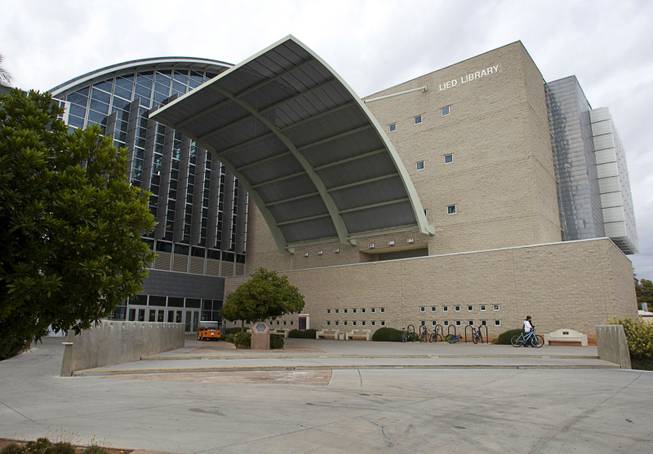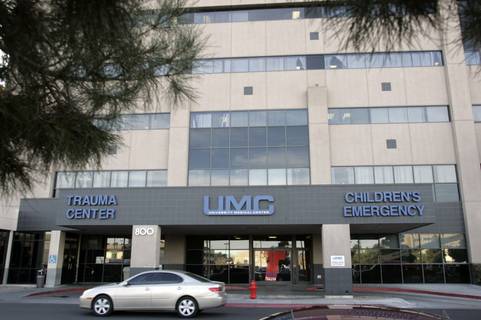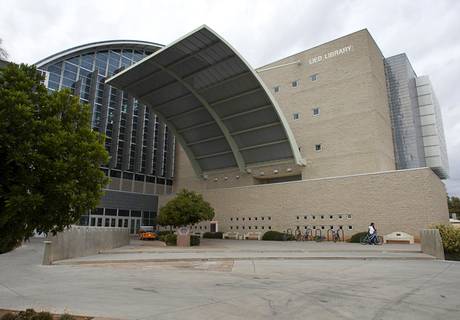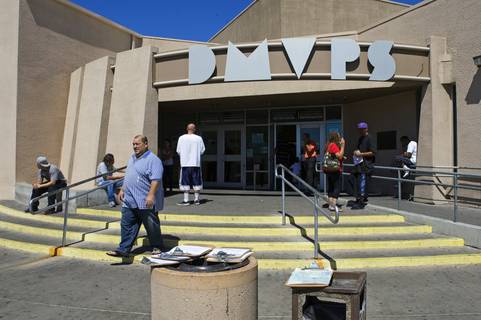
The Lied Library at UNLV. The Census Bureau reports that Nevada’s public employees, particularly higher education instructors, were hard hit by the recession in 2010. Also heavily impacted were state employees in parks and recreation and nonfinancial administration.
Friday, Sept. 16, 2011 | 2 a.m.
The recession exacted a heavy toll on Nevada’s public employees in 2010, a year after local and state government employment hit record highs, according to recent figures from the Census Bureau.
Particularly hard hit by the cutbacks: higher education instructors and state employees in parks and recreation and nonfinancial administration, the bureau’s Annual Survey of Public Employment and Payroll showed.
Government budgets have sagged under the weight of the state’s foundering economy, requiring round after round of cuts. Now the cuts have led to reduced payrolls.
Local governments — including cities, counties and school districts — in Nevada had the equivalent of 85,799 full-time employees last year, 1,335 fewer than in 2009, a 1.5 percent decrease. State government in 2010 had 28,345 full-time equivalent workers, 1,172 fewer than the prior year, a nearly 4 percent decline.
“Ultimately, these job losses mean that Nevadans are getting fewer services,” said Neil Lake, an HVAC technician at UNLV who is also president of American Federation of State, County and Municipal Employees Local 4041, which represents more than 4,000 government employees in Nevada. “Today we have thousands less people to help students, keep our neighborhoods safe and assist us at agencies like the Department of Motor Vehicles. Public-sector job losses are bad news for the economy and the services we care about in our communities.”
The Census Bureau also reported that gross payroll for state workers dropped from $139.4 million in March 2009 to $135.8 million in March 2010, but rose for local government workers from $412.3 million to $422 million over the same period.
Here is a look at some of the biggest losers in terms of full-time equivalence:
-
Photo by Steve MarcusEducation
Education represents the largest public employer at the local and state levels. The biggest hit was taken by higher education, whose ranks were trimmed to 10,128 positions last year, 1,174 less than in 2009 for an 11.4 percent decline. The sharpest decline was felt among professors and instructors, who went from 3,369 to 2,758, an 18.1 percent drop. Support staff fell from 8,067 to 7,370.
The declines came as no surprise to UNLV history professor Gregory Brown, chairman of the university’s Faculty Senate. UNLV alone closed 18 degree programs in nine departments over the past two years and last year saw the departure of 78 tenured faculty members. Others were laid off while vacancies remain frozen.
“We’ve seen a significant reduction in the public investment in higher education in the last three years,” Brown said. “One of the most significant concerns on this campus has been preserving the opportunity for students to get the degrees they want. Morale is an issue ... There is trepidation about whether we’re on sound financial footing.”
Professors are teaching more classes and advising more students. Workloads have already increased 15 percent per professor on average, according to the latest university audits.
Elementary and secondary schools had 45,230 employees in 2010, 828 fewer than the previous year. That included 216 fewer teachers but support staff took the bigger hit, losing 612 positions despite making up barely more than a quarter of all school employees.
The silver lining for those who kept their jobs was that payrolls increased by $9 million for public school employees and $1.7 million for those in higher education when comparing March 2010 to March 2009.
-
Photo by Steve MarcusNon-financial administration
Non-financial administration at the state level includes employees in personnel, information technology, planning, legislative activities and other functions that don’t involve taxation or fund management. Their numbers fell from 1,275 in 2009 to 933 last year, a 26.8 percent drop, the steepest decline among state and local government employees last year. Local governments lost 116 positions.
“There is no question state workers are doing more with less,” said Mary-Sarah Kinner, spokeswoman for Gov. Brian Sandoval. “While it is too early to determine direct impacts in specific areas, we do know that many agencies have realigned some functions to be able to provide customer service and get their work done in a timely manner.”
State departments being restructured include administration, personnel, information technology, tourism and cultural affairs. The Department of Motor Vehicles also has been hit hard, with the loss of 135 full-time equivalent positions in the past two years and the closing of three offices in Northern Nevada. But the department has combated those losses through increased use of online services.
-
Photo by Leila NavidiParks and recreation
In parks and recreation, the state had 153 state employees last year, down 20.7 percent from the previous year. Local governments saw their staffs reduced from 3,870 to 3,727.
-

Photo by Sam MorrisHospitals
Local government employees working in hospitals last year totaled 4,606, down 3.3 percent from the prior year. University Medical Center, the only public hospital in Southern Nevada, accounts for a full-time equivalent of 3,224 employees with an additional 576 on call as needed.
“We are not filling some open positions,” UMC spokeswoman Danita Cohen wrote via email. However, our daily patient census has also decreased, so we are not feeling the effects of fewer employees. Our drop in patient census mirrors a similar reduction in the number of employees.”
-
Photo by Erin DostalLocal libraries
Employment at libraries fell from 1,037 to 976, a 5.9 percent decline. The Las Vegas/Clark County Library District lost the equivalent of 69 full-time positions last year, many in middle management, giving supervisors more employees to oversee. There were also reductions in backroom operations with fewer book sorters and drivers to transfer books from one library to another.
Much of that loss, though, was absorbed by a “floating circulation” policy that allows a book to be shelved at the library where it was returned, even if it is a different branch from the one where the book was checked out. Jeanne Goodrich, the district’s executive director, said libraries also reduced their weekly hours from 72 to 60.
“We had a 17 percent reduction in our hours but our workload went down only 8 percent, which means we’re busier every hour that we’re open,” Goodrich said.
Not everything was gloomy in 2010 for public employees, though. State and local government experienced staff increases for financial administration, police protection, welfare, health services and natural resources. The state also had larger staffs for judicial and legal functions, highways and hospitals, while local governments employed more workers for sewer services and housing and community development.






Join the Discussion:
Check this out for a full explanation of our conversion to the LiveFyre commenting system and instructions on how to sign up for an account.
Full comments policy